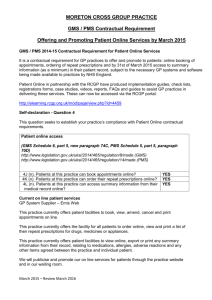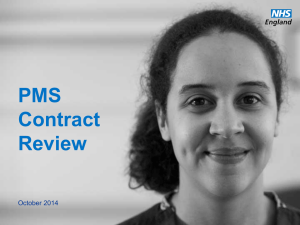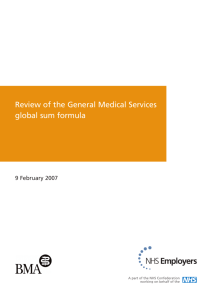Focus on the global sum allocation formula (Carr-Hill Formula)
advertisement
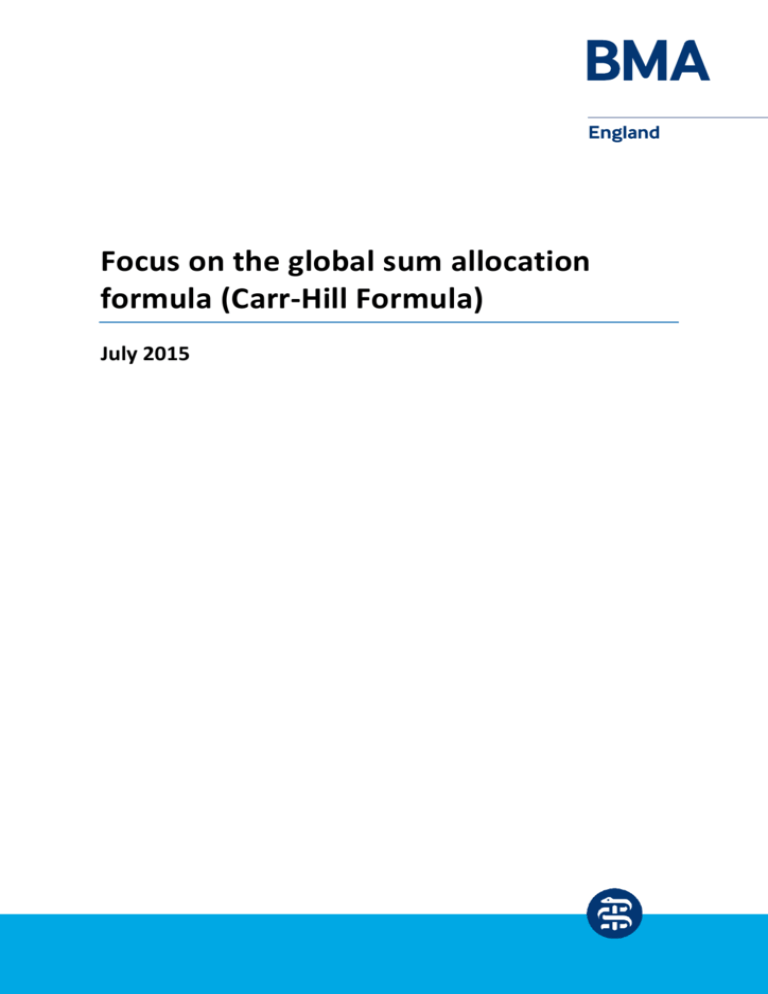
Focus on the global sum allocation formula (Carr-Hill Formula) July 2015 Introduction The global sum allocation formula, or Carr-Hill Formula, has been used as the basis of core funding for GMS practices since the inception of the new GMS contract in 2004. This short explanatory paper has been produced now because the allocation formula is newly relevant to many GP practices. There are two reasons for this: 1. The Minimum Practice Income Guarantee (MPIG), which protected a significant proportion of GMS practices from the full effect of the formula through correction factor payments, is being phased out over a seven year period. By 2020 the core funding of all GMS practices will be paid based on the global sum, increasing the significance of the allocation formula. 2. As part of the ongoing review process for PMS practices, the funding for most PMS practices is moving to a weighted capitation basis in line with GMS practices. This paper reminds practices how global sum payments are calculated and explains why the formula is currently being reviewed by NHS England. How the Global Sum Allocation Formula is calculated The global sum allocation formula is designed to ensure that resources are directed to practices based on an estimate of their patient workload and unavoidable practice costs. The formula is different from that used for CCG allocations. The global sum includes various components but the main payment is based on the GP registered patient list-size adjusted, through the Carr-Hill Formula, to reflect differences in the age and sex composition of the practice, together with a range of factors which take into account the additional pressures generated by differential rates of patient turnover, morbidity, mortality and the impact of geographical location. Specifically, the Carr-Hill formula adjusts the list size of practices based on: An assessment of the drivers of workload at GP practice level based on patient age and sex, including patients from nursing and residential homes additional needs of patients an adjustment for list turnover An adjustment for GP practices experiencing different ‘unavoidable costs’ for meeting the same workload using: a ‘Staff Market Forces Factor’ an assessment of the rurality of the practice When the new GMS contract was designed there were only limited ways of measuring workload factors for individual practices so the formula was derived from a sample of practice data taken from the General Practice Research Database (GPRD) between 1999 and 2002. This exercise looked at file opening times (instances of a patient’s computer file being accessed) for each patient to assess, imperfectly, surgery-based consultations. The GPRD did not adequately capture workload associated with home visits but this was inferred from other sources. Similarly, separate studies were carried out to generate information on the workload associated with patients in nursing and residential homes. Page 2 of 5 DRIVERS OF WORKLOAD Patient age and sex Patients of different ages and sexes attract a different level of payment under the Carr-Hill Formula based on an age-sex cost curve. Additional needs of patients In designing the allocation formula, the impact of indicators of mortality and morbidity on consultation frequency were modelled using the Health Survey for England data between 1998 and 2000. Of the variables tested, Standardised Limited Long-Standing Illness (SLLI) and the Standardised Mortality Ratio for those under 65 were found to be significant and the best at explaining variations in workload over and above age and sex. These are both related to practice workload within the formula. List turnover The formula recognises that patients in their first year of registration in a practice tend to have more consultations than other patients with otherwise similar characteristics. An uplift is therefore applied to all new registrations. UNAVOIDABLE COSTS The formula recognises that practices are likely to face differing costs of delivering a service depending on location and structure. Staff Market Forces Factor This component of the formula reflects the geographical variation in staff costs that practices will incur. It was developed using the same methodology as that used for general NHS allocations. Rurality The impact of rurality was modelled using Inland Revenue (now HMRC) information on GP expenses aggregated to practice level. The impact of population density and dispersion was modelled against GP expenses, controlling for other factors. These two factors are included in the allocation formula. It was decided not to include an adjustment for practice size, despite acknowledgement that larger practices benefit from economies of scale, because such an adjustment might have resulted in perverse incentives for practices to disaggregate. The same reasoning was used to discount multiple sites within a practice. How the formula is applied Each adjustment within the formula generates a separate practice index, comparing the practice score on the adjustment to the national average. The indices are then simultaneously applied to the practice list to produce a practice weighted population. This is calculated quarterly. Page 3 of 5 The formula under review The 2007 formula review When the new GMS contract was introduced, the Department of Health, the BMA’s general practitioners committee (GPC) and the NHS Confederation gave a commitment to review the global sum allocation formula in light of the developing contract. A formula review group, established in 2004, including NHS Employers, members of the GPC and representatives from the four UK health departments, used a detailed examination of the formula to evaluate its robustness. It also investigated a number of additional factors for possible inclusion in a revised formula, taking into account new data and stakeholder feedback on funding allocation. A report of this group, published in 2007, made recommendations as to how the current formula could be improved in the future. On the whole, the Formula Review Group’s report concluded that the Carr-Hill formula was sound but it recommended some modifications to the current allocation formula. The data used to underpin the workload element of the formula came from the QResearch data, a different source to that used by the Carr-Hill formula. The 2007 review suggested that any revised formula should include a: workload adjustment (comprising age-sex bands, newly registered/temporary patients and an index of multiple deprivation) supplemented by consultation length and home visit adjustment staff market forces factor adjustment cost of recruitment and retention adjustment ‘Cost of Unavoidable Smallness’ adjustment rurality adjustment (possibly) The 2007 review considered a number of other factors which it did not recommend for inclusion in a revised formula, namely: QOF prevalence, patients living in nursing and residential homes, ethnicity, patients who speak a different language from their GP and the GP Market Forces Factor. Ethnicity and language were not included as the data at the time produced counterintuitive results. The Formula Review Group’s remit was only to review the formula, implementation of its recommendations was left to negotiation between GPC and NHS Employers. A consultation was carried out after the review which invited the views of GPs, LMCs and other stakeholders including primary care organisations and patient groups. At the time, the GPC asked practices and LMCs to consider whether the recommendations should be implemented in light of the fact that, without additional funding (unlikely at the time), new winners and losers would be created. Most primary care organisation respondents (75%) felt that a new formula should be implemented based on the 2007 review, but only 29 per cent of GP respondents shared this view (48% disagreed and 23% did not know). When asked if they would like to see implementation of a new formula, even if the resulting redistribution would meant that some practices would lose income, 62 per cent of GP respondents answered no. In the end, the group’s recommendations were not implemented. Page 4 of 5 The current formula review No formula will ever be perfect but, though changes to the formula were not made following the 2007 review, it is widely acknowledged that there is probably scope for updating and improving the formula. Common concerns include: The formula produces per patient weightings that vary very widely between practices, raising objections that such large variation lacks face validity, particularly given how many costs are shared by practices regardless of population characteristics. That the formula is unable to cater for the needs of atypical populations such as unavoidably small rural practices and university practices. This deficiency was masked by MPIG and PMS funding but is increasingly being brought to the attention of policy makers as additional income streams are phased out. That the needs of some population groups, particularly very deprived populations, are inadequately reflected in the formula. As part of the contract negotiations for 2015/16, the GPC and NHS Employers agreed to re-examine the Carr-Hill Formula with the aim of adapting it to better reflect deprivation. This work began in 2015 and is currently underway. A parallel workstream has been set up to examine the needs of atypical practices, for whom a formula is unlikely to ever prove satisfactory. Unfortunately there is still no way to assess properly individual practice workload, so the formula review will again be based on an assessment of workload across a sample of practices. The current review will however be able to look at more up to date information to assess differences in workload at practice level. Understandably, some practices, particularly those losing MPIG and PMS funding, hope that the current formula review will result in changes which will bring in much needed additional funding to support services for their patients. The review group is likely to report in time to inform contract negotiations for 2017/18 but implementation will be dependent on negotiation and will have to take into account detailed modelling of the impact of any change at individual practice level, as well as the availability of new funding to make any formula change viable. We would advise practices losing funding through MPIG and PMS reviews not to rely on the outcome of the current formula review but to consider all available avenues for stabilising practice funding and services. [We also encourage PMS practices to seriously consider reverting to GMS for the additional security provided by the national contract.] The GPC is represented on the groups currently reviewing the formula but does not view the work as a panacea for the problems in general practice. It has expressed caution about the risk of creating new winners and losers if destabilising changes are made to the formula without sufficient additional investment. It has also urged NHS England to proceed with an open mind about the relative differences in workload demands of different population groups. Above all, the GPC will continue to remind Government that the review must not distract from the real funding problem facing all practices, which is inadequate overall investment in primary care, particularly in the context of increasing population demands. Page 5 of 5


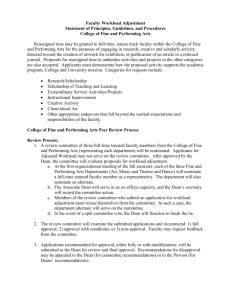

![Guidelines for Academic Workload Allocation[1]](http://s3.studylib.net/store/data/007357775_1-c08378375a61bf04d5de327b7ce434b5-300x300.png)
